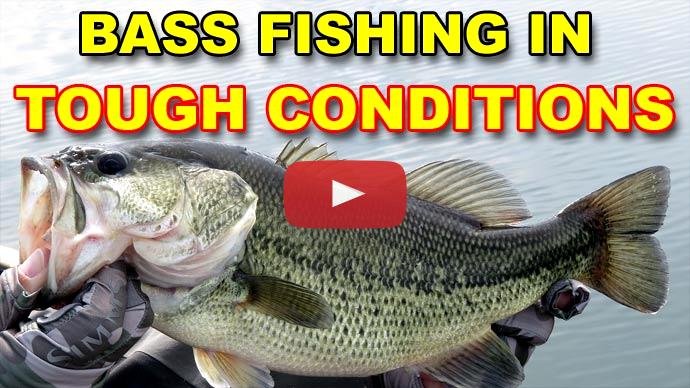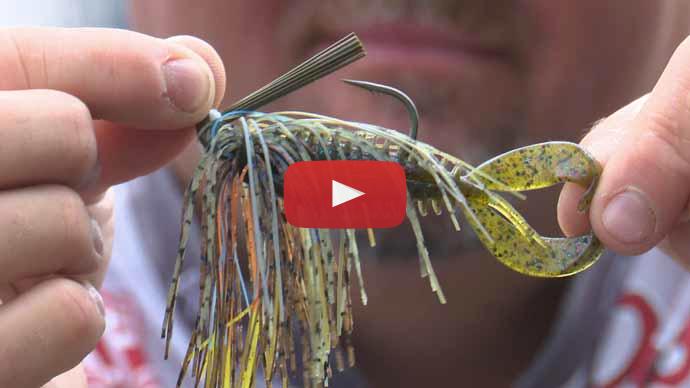Hey guys, Bassmaster Elite Series pro, Wes Logan here. I want to talk to you a little bit about fishing in the springtime. And when I say springtime, we're talking water temperatures from anywhere from 50 to low 60s. No matter where you are in the country, that's going to be your springtime temperature. That's when the bass really get to thinking about spawning, moving up shallow, getting on their beds, the males move up first, all that good stuff. So pretty much your early spring is going to be your low 50 degree water temperature. So that's going to be hardcore pre-spawn 90% of the time.
So basically how I'm going to approach a lake or any body of water I'm on that time of year is you want to find places that are a little bit protected, I feel like. And one little key that I try and like doing a little bit of map study, if you can ever find a place that's, let's just say you've got a main reservoir and you have a branch off of it, like a big bay or anywhere that they would be potentially spawning in, well if you can find one that runs back north, it's going to be protected from a north wind, which is going to be your normal wind in the wintertime coming into spring, which is going to bring that colder air in. With that being protected, it's going to be protected out of that wind. It's going to get a little bit warmer if you get a real bright sunny day. So that water is going to be a little bit more consistent, a little bit higher in temperature, and the fish are going to gravitate there first to start their spawning process. So that's a good place to start in that early spring for just trying to get an idea of what the fish are doing, trying to figure out what they're holding on. That's kind of the places you would try and start.
So moving into what they would be holding on in particular, and what I mean by that is what you would be targeting, like shallow cover most of the time that time of year, or those same type of places, you could find places they would set up, like going into like the mouth of that would be a high spot or the main lake points, but anywhere going into those places that are going to be protected from that wind.
As far as cover goes, I'm going to be looking for most of the time anything hard. It kind of depends on what reservoir you're in or body of water. If it's majority of grass, obviously you're going to be focusing on grass. From a grass standpoint, they can either be in the thickest grass, where there's a bunch of it, or the vice versa. There'll be a lot of grass, and you try and find where there isn't any grass, where there's voids in it. It'll just kind of depend on how much is there that time of year and how the fish are relating to it, and you'll have to have the fish kind of tell you what you're looking for when it gets to that situation.
From a hard cover standpoint, you'll have laydowns is a really good one. Rocks are probably the biggest key in the early spring, and if your lake has docks, that can be a really good pre-spawn set up place.
From a bait standpoint, any type of reaction bait is probably going to be your best bet. Cover water, but cover water thoroughly. You're going to cover a lot of water, but fish it like you want to kind of pick stuff apart because they may not be very aggressive. If you have a really high percentage piece of cover, like a big laydown on a little bitty point or something, you want to throw it three or four times across at different angles, and you may get that fish to react from a different angle or different speed, something like that.
That's going to be kind of the gist of the pre-spawn. Just find places that are protected. Reaction baits are a big deal. Red's a big deal in the springtime color-wise. Any type of bait, vibrating jig, square bill flat side, lipless bait, all of those are really good. I will have a flipping bait on most of the time, a jig, in the early spring, just because it seems to get a bigger bite if you do get one, but normally you don't get very many.
Transitioning into that water temperature that's 55 to 58, 59, where the first few, they're starting to creep up there. You may be catching a few male buck bass on the real obvious stuff, like where some beds would potentially be. This is probably the best time to catch some of the biggest fish in the lake as they're pulling up shallow, because a lot of times I've seen that the bigger fish in places tend to spawn first. I'm talking about your, depending on where you're at, whether you're there 5 or 6 pounders or 7, 8, 9 pounders, they always tend to spawn first. That's going to be your best opportunity.
That's when I really like to focus hardcore on the bank structure. Places that are, you might have a place, let's just say the edge of a seawall where a bed might be and you might catch a 13-incher there. If you have a dock right beside it that's got a little bit of water on it, that could be where that female is setting up. You actually catch a 6 or 7 pounder that's waiting to ease up on the bed, whether waiting on a full moon or anything like that. Again, that's where I really like to focus on the hardcover on the bank, not as much as the offshore stuff.
Start pitching around a Texas rig when the water gets that temperature because they're in that spawning mood. They're really not wanting to eat. They're not very aggressive. That Texas rig tones it down a little bit and you tend to get a few more bites.
A wacky rig's really good going into the spawn. A buzzbait can be really good depending on what part of the country you're in, what kind of fish you're dealing with. I'm trying to think. Buzzbait's a really key deal in that early spawning situation, that 58 to 60. It can get you some really good bites, but that's how I approach it.
Late spring, and this is going to be full blast, hardcore on the bed. They'll be laying everywhere you're looking forward to that full moon or a new moon because you're going to have a new wave pull up at least two times per month. In between those, you'll have stragglers playing around, doing their deal, guarding fry, guarding the nest and all that good stuff.
Wacky worms are a really big deal. A Zoom Zlinky is kind of what I like to throw, just weightless on a spinning rod. A Zoom Trick Worm's really good, just rigging it weightless. Texas rig, if you've got a lot of cover, bank grass or bushes or anything like that, that's a lot more efficient to throw than the wacky rig. It just gets a lot of bites. They can't really stand it.
Again, they're not wanting to eat. They're just trying to protect in more of a protective mode, that's a really good deal. A Pop-R can be really good. Again, just pitching around a Texas rig. I still am shying away from the jig on that deal. Then you're going to have your full blown sight fishing.
Again, this is all going on from the very beginning of the protected places. They're going to be your first, but as we get into this water temperature, the whole lake's probably going to come into play.
That's how I break down the springtime from pre-spawn to full-blown spawn and a little bit into the post-spawn. There's a transition from spring to summer on that post-spawn deal where even the late spring, you'll be dealing with some post-spawn fish, but they'll still be relating to a spawning situation, whether it be their bed or anything like that. From a bait standpoint, all those are really good. You just kind of have to get the fish to tell you what they want that particular day.
The big thing in the spring is the fronts. When they can come in, they really affect it more than any time of year just because the fish are trying to get up their shallow, trying to warm up because it's been so cold all winter. You get a cold front end, stuff really starts to slow down. Sometimes it'll set the fish back a week and a half to two weeks just depending on how severe the front is or how much flooding you get.
Again, that goes back to finding those protected areas. If you have some fronts roll in, just revert back to where you started with the pre-spawn deal if you've gotten into that spawning situation. If you get far enough along in the spawn and you get a weather day or something, it may only affect them for a day or two, not as near as bad as it would early in a pre-spawn situation.
Hopefully that helps on a spring fishing situation for you guys. Be sure and get out there and get after them. All those baits, all those places, that's what I look for. I hope this helps and we'll see you guys next time.



